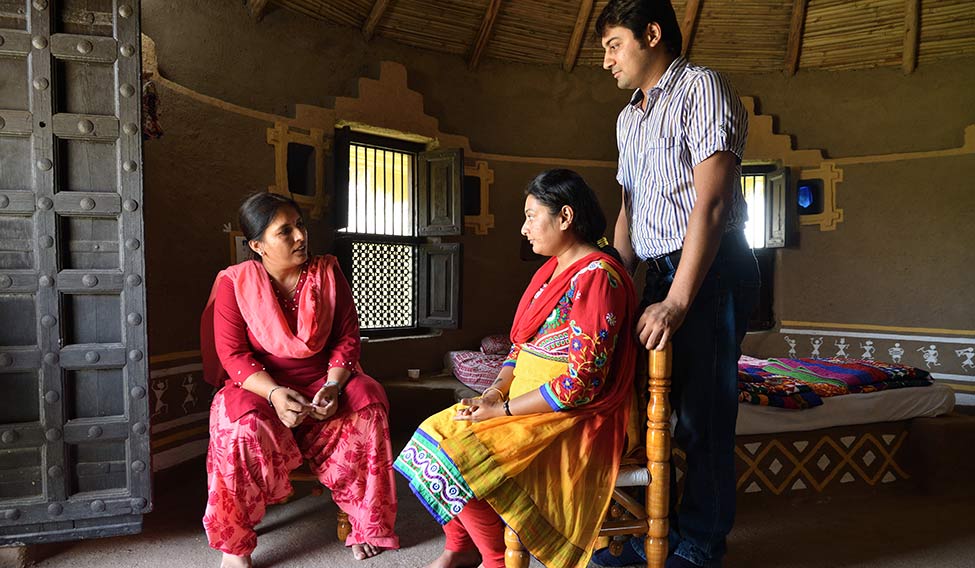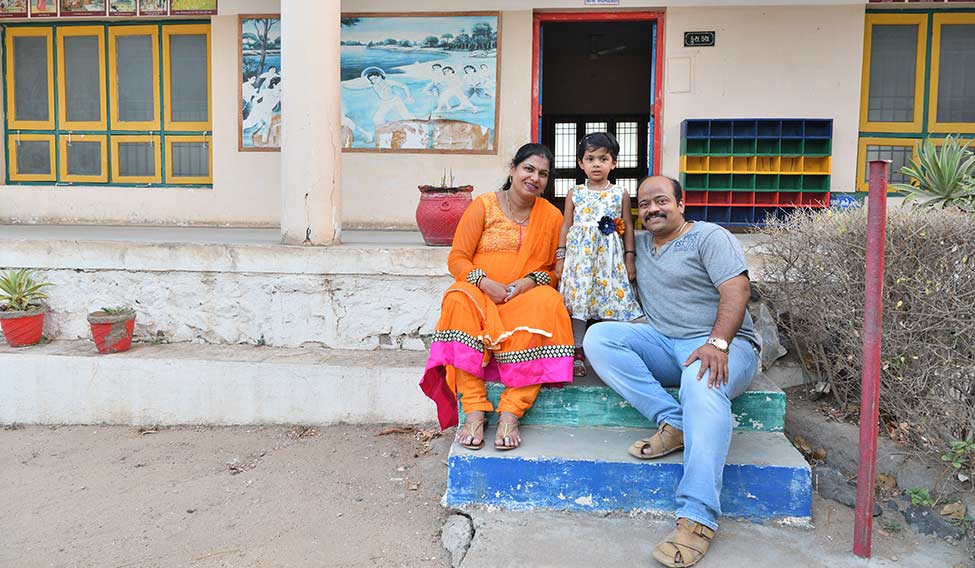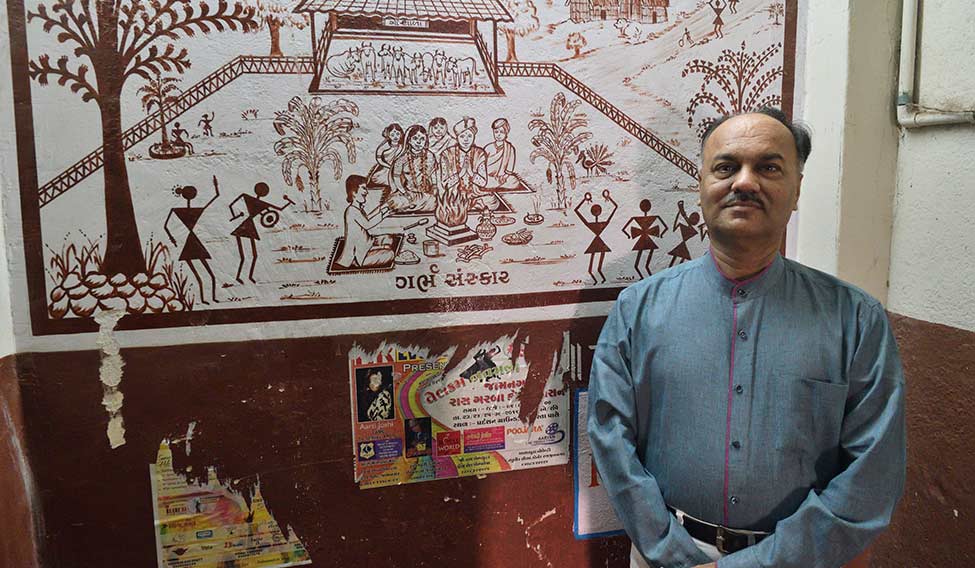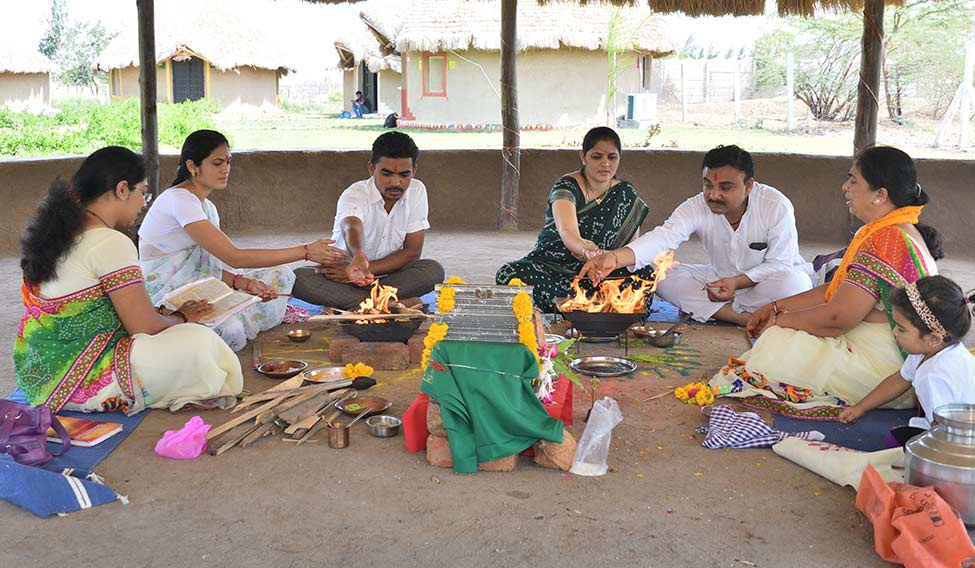Imagine you have a glass full of oil, and you need to take it up a flight of stairs,” says Dr Karishma Narvani, a practitioner of ayurveda at Jamnagar in Gujarat. “While carrying the glass, you will have to be very careful, right? That's how we make couples understand pregnancy.”
We are sitting in Ved Garbha Vihar Private Limited, Narvani's new pregnancy retreat. It is a modern village of sorts—individual huts with walls freshly plastered with mud and cow dung; rustic interiors fortified with the modern comforts of split air conditioners and flat screen televisions.
Narvani, 39, a graduate from Gujarat Ayurved University in Jamnagar, is national convener of the garbh vigyan sanskar project, an initiative of RSS's health wing Arogya Bharati. She has been working on 'garbh sanskar', the ayurvedic science of the uterus for 'best progeny', for the past eight years and the pregnancy retreat is just an extension of her work. She has a private clinic for “vedic pregnancy”. She also provides free consultations at Garbh Sanskar Vigyan Kendra in Jamnagar, and delivers lectures on 'garbh sanskar' for RSS-affiliated organisations such as Vidya Bharati, Saraswati Shishu Mandir, and Rashtriya Sevika Samiti, women's wing of the RSS.
“Garbh sanskar is part of our syllabus in Bachelor of Ayurveda Medicine and Surgery. We are only developing it further,” says Narvani. The concept is part of Charak Samhita, an ancient system of Indian traditional medicine. Narvani says the sanskar or ayurveda regimen that she offers pregnant women is a holistic one, which focuses on enhancing the qualities, and preparing the body, mind and soul for producing the 'best progeny'.
Framed within the philosophy of Hindu nationalism, the regimen begins days before conception and moves on to antenatal and postnatal care for women. “Look at this figure,” says Narvani, pointing to a map of India with images of several nationalist icons such as Vivekananda, Sardar Vallabhbhai Patel, Veer Savarkar; icons that prospective parents must aspire for when they plan their babies, says Narvani. It also includes mythical characters like Ram, Sita and Krishna. Interestingly, the map titled, 'Samarth Bharat [Capable India]', doesn't have the northernmost parts of India.
 Ancient wisdom to rescue: Dr Karishma Narvani (left) with Kajal and Hasil Gosrani, who came to Ved Garbha Vihar after other infertility treatments failed | Sanjay Ahlawat
Ancient wisdom to rescue: Dr Karishma Narvani (left) with Kajal and Hasil Gosrani, who came to Ved Garbha Vihar after other infertility treatments failed | Sanjay Ahlawat
“None of these people were accidental births. They were all planned,” Narvani insists. She cites the example of Swami Vivekananda, whose mother, Bhuneswari Devi, knew what kind of a progeny she wanted since her teenage years. Narvani also talks about Kayadhu, Hiranyakashyap's wife, who didn't want her child to inherit his father's demonic qualities. So she followed a strict regimen during her pregnancy and her efforts paid off when she gave birth to Prahlad, who was a devout follower of Vishnu.
The project has been at the heart of a raging debate after media reports claimed that it was promoting a regimen for producing “super babies” with “fair skin and high IQ”. One of Narvani's lectures, held in Kolkata in May, met with fierce opposition from the head of West Bengal's Commission for Protection of Child Rights, who filed a PIL to prevent the lecture from being held, arguing that it was “unscientific and regressive”. Arogya Bharati, however, issued a press statement countering that the PIL was “dismissed” by the High Court. The statement further said that the court had made the comment that the intention of Arogya Bharati was not to create designer babies, but to assist pregnant women to have healthy babies through an easy delivery.
“All parents want a strong, healthy, beautiful, genius child; it is normal to have such desires. And ayurveda can make it possible,” claimed Narvani in her controversial presentation. When asked about producing tall, fair and high IQ babies, Narvani said the elaborate regimen only “enhanced” the qualities such as the structure of the skin cells, and prescribed practices such as solving sudoku and puzzles for “brain development” of the foetus.
In her brochure on garbh sanskar, Narvani quotes liberally from Manusmriti, and claims that rituals and astrology are the basis for having a son or daughter, with an addendum that a son means having a “santan, vaaris (child, heir)”.
The best progeny regimen developed by Narvani and her mentor, Dr Hitesh Jani, head of department of Panchkarma at Gujarat Ayurved University, is an elaborate process that starts before conception. Couples are given specific dates and timing based on astrology for planning conception “to invite the best spirit”. It is followed by the process of “cellular purification” or cleansing. There are specific massages, and rituals and practices such as music therapy, chanting of shlokas, reading texts like Gita during specific months.
 Success story: L. Raghavendra Rao with wife, Anupama, and daughter. Rao came to Ved Garbha Vihar after he lost his first child to osteopetrosis, a genetic disorder | Sanjay Ahlawat
Success story: L. Raghavendra Rao with wife, Anupama, and daughter. Rao came to Ved Garbha Vihar after he lost his first child to osteopetrosis, a genetic disorder | Sanjay Ahlawat
A detailed diet plan is designed to “enhance” certain qualities of the unborn child. The pregnant woman is asked to stay away from western music as it results in an “angry and irritable” child, and avoid watching 'saas-bahu' soap operas to prevent negative emotions. “A foetus is like [a] hardware made up of different softwares, including qualities and traits such as immunity, sense of humour, lifespan, among others,” says Narvani. “We cannot really change the software, but we could ensure that the best spirit is invited,” she says.
Narvani says that most couples want an intelligent child who would be able to take up a good career later on, but she contends that mere professional success is not the goal of the programme. “They have to have good qualities and contribute to society and the nation, too,” she says.
A healthy, disease-free population, says the garbh sanskar brochure, only implied “positive eugenics”, and in a conception that is based on complex astrological science, the gender, mentality and behaviour of the child could be predicted.
Jani, who is also project co-ordinator for the Swasth Gram Yojana Project, insists that the concept of “genetic engineering” through ayurveda implied that the body “cleaned” the waste from the cells “on its own”, and that was the highlight of the programme. “This is unlike the western concept of gene editing where interventions are made by scientists. We are not interfering with nature. We are only making the body flush out its waste,” he insists.
The “experiment”, says Jani, started about 11 to 12 years ago, when a case of thalassaemia in a Jamnagar village caught his attention. Since both parents were carriers, they lost their first child. Jani found that genetic diseases like thalassaemia were common in the Ahir community where inter-marriage was common.
 Joint effort: Dr Hitesh Jani, who along with Karishma Narvani, developed the best progeny regimen | Sanjay Ahlawat
Joint effort: Dr Hitesh Jani, who along with Karishma Narvani, developed the best progeny regimen | Sanjay Ahlawat
Through ayurvedic processes, Jani says, genes can be “upgraded” and genetic anomalies weeded out. The experiment was conducted on several couples through the years, beginning with treating those who were infertile. Today, Jani says, his experiment has succeeded with 450 couples, many of whom have had children with no genetic anomaly. The shastras prescribe the science of vichitra vidya, says Jani, where gene modification can take place—a bitter gourd seed can be modified to turn it into a brinjal, for instance. “But that process is not advised, and certainly not with humans,” he says.
The difference in appearance, emotional and social capabilities, and height are thought to be because of environmental influences which cause a differential expression of the genes without any alteration in the biological structure, says California-based clinical neurologist Dr Jay Desai. “The environmental influences that can alter gene expression may include what we eat, who we interact with, where we live, our social and emotional experiences, and whether we exercise regularly or not,” he says.
The premise that enriching the environment of the foetus in-utero [inside the uterus] and using certain medicinal products during pregnancy would lead to a better offspring is not based on enough facts. “The environmental influences that alter gene expression are still poorly understood by scientists,” says Desai. “Arogya Bharati has not published any data for us to accept that their methods are scientific or that they understand the concept of epigenetics [a field that studies the effects of environment on gene expression] better than scientists. Their ayurvedic medicinal data is non-existent.”
When asked about the programme, Vaidya Sanjiv Oza, vice chancellor of Gujarat Ayurved University says, “Any research is a continuous process, and even after gathering clinical data, it doesn't imply that the findings are complete and final. If this data was presented as part of a doctorate programme, we would have certainly looked into it.” The parameters for judging an ayurvedic research had to be different from allopathic medicine, free from prejudice, says Oza. “It must not be perceived as a saffronised project.”
Of 400 couples the programme claims as its success stories, THE WEEK met a few, most of whom had their own reasons for opting for the treatment. For some, it was the failure with infertility treatment that made them turn to garbh sanskar; for others it was the diet plan, the use of music and mantras that helped them communicate better with their unborn babies. Still others said that it was a search for a solution to a genetic disease when both parents are carriers.
L. Raghavendra Rao, 35, lost his first child because of osteopetrosis, a rare genetic disorder that affects the bones. “We got our DNA profiled when the doctors gave up on us,” says Rao, who is from Hyderabad, but now lives in Gandhidham in Gujarat, with his wife. “We are first cousins, and carriers of the disease. Before our second child was born, we were told that there was a 25 per cent chance the child would have the disease. When we heard about the garbh sanskar project, we thought of giving it a shot. We had a disease-free child and another one is on the way,” says Rao.
Apart from doing yoga and following a diet plan, the couple gave up watching soap operas and eating out, and adopted a vegetarian diet. Most couples who underwent the treatment say their children are calmer and took their first steps earlier than usual.
Kajal and Hasil Gosrani were thinking of adopting a baby when they heard about this programme and became part of it a year ago. “We spent lakhs of rupees on infertility treatments for many years. But it was just not working out. So we decided to try this. The yoga is refreshing and the medicines have helped cure my polycystic ovarian syndrome,” says Kajal, 32.
A homemaker, Kajal wants to have a “healthy and strong” child. “I have followed every ritual. Though our families have been supportive despite the failures, this time it has to succeed,” she says. “After all, no one will ever blame a man. In our society, only a woman is blamed for not having children, isn't it?”







